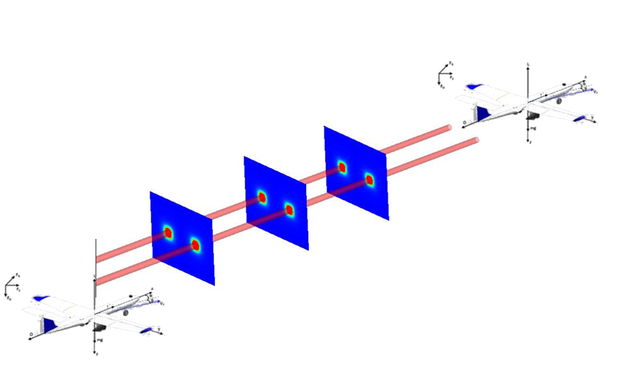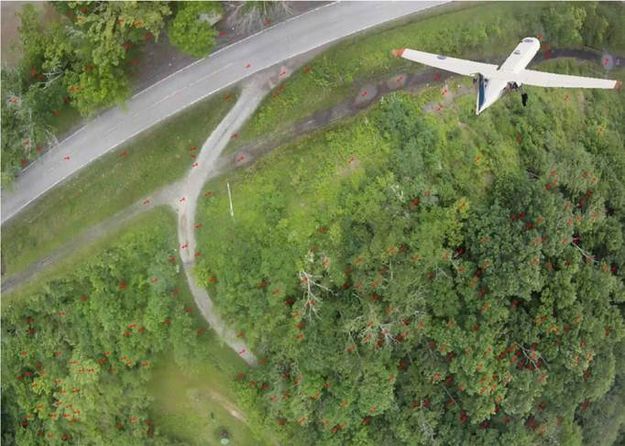Research
Research
CUSL‘s research interest is in the areas of estimation, control, and dynamics of unmanned vehicles with an emphasis on unmanned aerial vehicles. Current focus is on vision-aided navigation, wind/gust estimation, cooperative control, remote sensing, and small UAV development. Please send Dr. Haiyang Chao an email if you want to get a reprint of our paper or if you want to use our disaster damage data in your research.
Our UAS flight tests are covered by FAA Blanket Certification Of Authorization (2016-CSA-138-COA) as well as Section 333 UAS exemptions. We are authorized to fly in any class G airspace and certain class E airspace (Certification Of Waiver).
FAA certified drone pilots: Harold Flanagan, Pengzhi Tian, Dr. Haiyang Chao.
Active Projects:
USDA-NIFA National Robotics Initiative (NRI): Collaborative Autonomy and Safety for Teamed Human- Unmanned Aircraft Systems in Fast Evolving Wildfire Environment 2018-2023
Small unmanned autonomous systems can be deployed for different scientific research projects including but not limited to aviation safety research, atmospheric measurement, agricultural/environment monitoring, emergency response, etc.
KHawk - Flying Wing UAV
KHawk 48"-1 Flight Test
1. KHawk flying-wing-48 manual takeoff
2. KHawk Flying Wing 48 Auto-Circling
FAA Wake Encounter for Small UAS 2020-2022
Wake vortices generated by the leading aircraft can have a big impact on the following manned or unmanned aircraft. The current FAA regulation do not allow UAS operations at or close to the airport. New research is needed to evaluate the safety requirement for small UAS operations at or close to the airport.
Former Research Projects:
Modeling of UAS and Wind Interactions
- Publications
- Chao, H., Flanagon, H., Tian, P., and Hagerott, S.G., Flight Test Investigation of Stall/Spin Detection Techniques for a Flying Wing UAS, AIAA Atmospheric Flight Mechanics (AFM), 2017
- Flanagan, H., Hagerott, S.G., and Chao, H., Model Based Autopilot Gain Tuning for Attitude Tracking of Unmanned Aerial Vehicles, AIAA Infotech Conference, to appear, 2018.
KHawk UAS Stall Test
Cooperative Sensing of Spatio-Temporal Wind and Turbulence Using Multiple UASs, KU-GRF, 2017-2018
It is well known that the atmosphere is turbulent in the Atmospheric Boundary Layer (ABL). The dynamically changing wind, wind shear, and turbulence can have a big impact on manned or unmanned aircraft.
- Publications
- Tian, P., and Chao, H., Model Aided Estimation of Angle of Attack, Sideslip Angle, and 3D Wind without Flow Angle Measurements, AIAA Guidance, Navigation, and Control Conference, to appear, 2018;
Autonomous Tornado Damage Track Mapping Using a Small UAS, NASA-Kansas-EPSCoR PDG, 2017
Tornadoes are among the most dangerous natural disasters for states in the “Tornado Alley”. From 2010 to 2014, tornadoes in the US caused 764 fatalities and approximately $17 billion damages with more than 5600 times of occurrence. Small UAS can serve as a complementary remote sensing platform to provide high resolution imagery at multiple spectral bands in near real-time. This emerging remote sensing platform can help provide accurate low-altitude validations of satellite tornado damage estimates and provide quicker situational awareness after tornadoes.
- Publications
- Gowravaram, S., “Multispectral Remote Sensing of the Earth and Environment Using KHawk Unmanned Aircraft Systems,” M.S. Thesis, Aerospace Engineering Department, University of Kansas, July 2017;
- Gowravaram, S., Flanagan, H., Tian, P., & Chao, H. (to appear in 2018). AIAA InfoTech Conference. Prescribed Fire Monitoring Using KHawk Unmanned Aircraft Systems.
An EF2 tornado touched down in the region north of Farragut, Iowa on June 28, 2017. A portion of tornado damage track, which is a corn field, was covered by KHawk UAS flight on July 12 2017. RGB, NIR, NDVI aerial maps are shown in the following pictures. Full resolution disaster data can be acquired through request.
A strong hail storm was reported on June 22, 2017, which generated a 60-mile swath of crop destruction from Thomas, South Dakota to Marshall, Minnesota. The satellite RGB map is shown in the top of the following image (in courtesy of Andrew Molthan from NASA SPoRT). The UAS survey was performed on July 23-24. The orthorectified aerial map is shown in the bottom right subfigure. Full resolution disaster data can be acquired through request.
Wake Sensing and Suppression with Aircraft Formation Flight, NASA LEARN, 2014-2016
Birds fly in V or echelon formations for energy saving as well as enemy defense. The follower bird usually flies in the wakes generated by the leader bird. However, it is unclear how exactly birds interact with the wake vortices during close formation flight. Small UAVs offer ideal platforms for further understanding of the interaction between the aircraft and the flow field such as wake vortices generated by the leader aircraft. Such researches could potentially lead to significant fuel saving of commercial flights and help decreasing the waiting time at airport terminals.
- Publications
- Tian, P., He, A., Chao, H., Zheng, Z., and Gu, Y., Wake Encounter Simulation and Flight Validation with UAV Close Formation Flight , AIAA Guidance, Navigation, and Control Conference, 2017.
- Tian, P., Chao, H., Gu, Y., and Hagerott, S.G., UAV Flight Test Evaluation of Fusion Algorithms for Estimation of Angle of Attack and Sideslip Angle, AIAA Guidance, Navigation, and Control Conference, 2016.
- Chao, H., Gu, Y., Tian, P., Zheng, Z., and Napolitano, M., “Wake Vortex Detection with UAV Close Formation Flight”, AIAA Atmospheric Flight Mechanics (AFM), June, 2015
Collaborative Stereo Vision Sensing with Small UAV Formation, NASA-Kansas-EPSCoR SIG, 2014-2016
The accuracy of most stereo systems are highly constrained by the short and fixed baseline between the two cameras. A group of small UAVs flying in formation with one camera mounted on each aircraft can function as one collaborative sensing system with adjustable formation offsets based on requirements from stereo vision sensing. After combining the collected stereo vision data with onboard inertial data, this system can then be used for real-time 3D terrain reconstruction during emergency response, mobile target detection, and obstacle avoidance.
- Publications
- Zhang, M., Wang, G., Chao, H., & Wu, P. (2015). Fast and Robust Algorithm for Fundamental Matrix Estimation. In International Conference on Image Analysis and Recognition. (Link)
- Chao, H., Brink, K., & Miller, M. (to appear in 2017). ION Pacific PNT Conference. Collaborative Stereo Vision Based Relative Pose Estimation with Small UAS Formation.
Leader-follower formation flight of two KHawk UASs was achieved in Spring, 2016.
Preliminary visual odometry results and the 3D ground map are shown in the following figure.
Optical flow has been used by insects and birds for navigation functions such as obstacle avoidance, speed regulation, landing, etc. It also has big potentials to support small UAVs for short-range navigation in GPS-degraded or GPS-denied environments.
- Publications
- Rhudy, M., Chao, H., & Gu, Y. (2014). IEEE International Conference on Intelligent Robots and Systems (IROS). Wide Field Optical Flow Aided Inertial Navigation for Unmanned Aerial Vehicles. (Link)
- Rhudy, M., Gu, Y., Chao, H., & Gross, J. (2015). Unmanned Aerial Vehicle Navigation Using Wide-Field Optical Flow and Inertial Sensors. Journal of Robotics, 2015, 251379. (Link)
- Chao, H., Gu, Y., Gross, J., Rhudy, M., and Napolitano, M., (2016). Flight-Test Evaluation of Navigation Information in Wide-Field Optical Flow, AIAA Journal of Aerospace Information Systems (JAIS), Vol. 13, No. 11, pp.419-432, 2016 (Link).








